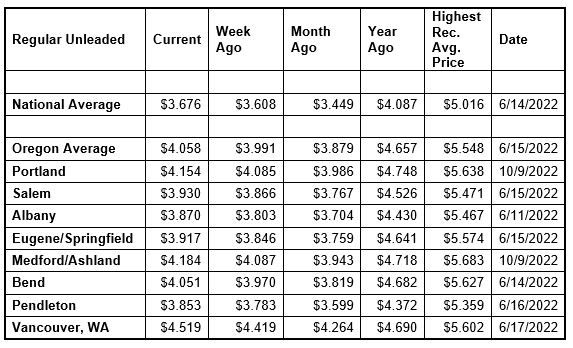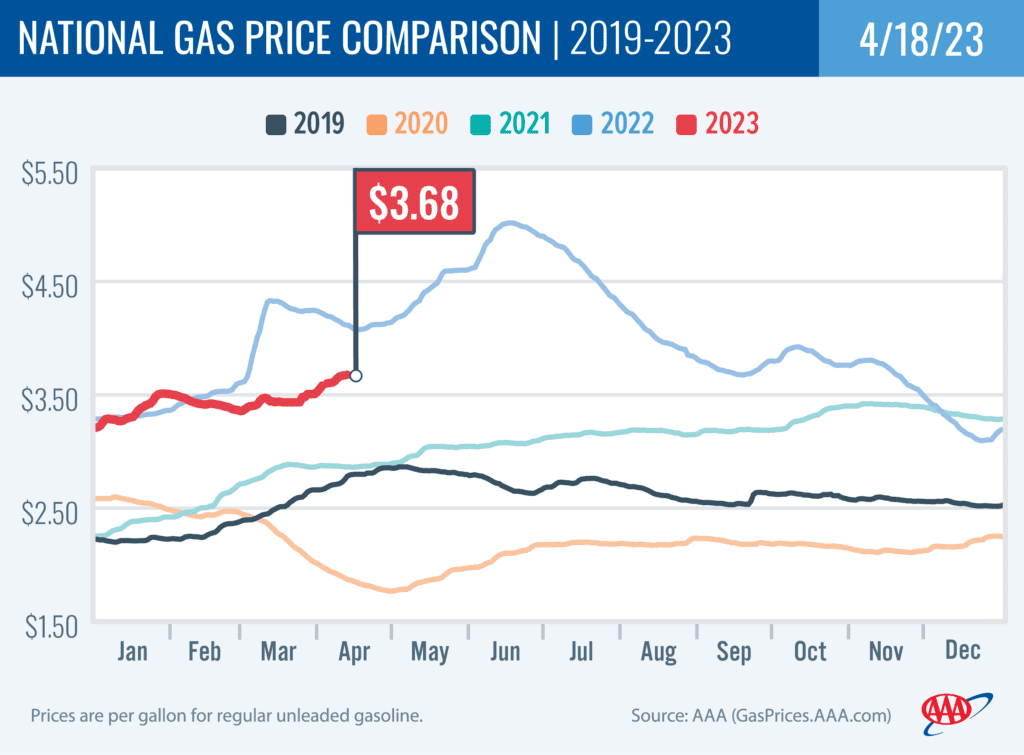PORTLAND, Ore., – Gas prices are climbing in almost every state again this week. The major driver is the higher cost of crude oil which has been hovering in the low $80s per barrel. Pump prices have been steadily edging up since late March. For the week, the national average for regular unleaded gains seven cents to $3.68 a gallon. The Oregon average adds seven cents to $4.06. This is the first week the Oregon average has been above $4 since mid-December.

“Crude oil prices above $80 per barrel put upward pressure on pump prices. As long as crude remains near the current level, drivers will likely see incremental price increases at the pumps for now,” says Marie Dodds, public affairs director for AAA Oregon/Idaho.
Oil prices rose above $80 per barrel after the April 2 announcement from the Organization of the Petroleum Exporting Countries and other major oil producers, including Russia, known collectively as OPEC+, that the cartel would cut oil production by just over 1 million b/d through the end of 2023. The move comes at a time when pump prices were already rising due to the switch to summer-blend fuel and seasonal higher demand.
Crude oil continues to trade around $81 today compared to $82 a week ago and $108 a year ago. In March, West Texas Intermediate ranged between about $64 and $81 per barrel. In February, WTI ranged between about $73 and $80 per barrel. In January, WTI ranged between about $73 and $82 bbl. Crude reached recent highs of $123.70 on March 8, 2022, shortly after the Russian invasion of Ukraine, and $122.11 per barrel on June 8, 2022. The all-time high for WTI crude oil is $147.27 in July 2008.
Crude oil is the main ingredient in gasoline and diesel, so pump prices are impacted by crude prices on the global markets. On average, about 56% of what we pay for in a gallon of gasoline is for the price of crude oil, 20% is refining, 11% distribution and marketing, and 14% are taxes, according to the U.S. Energy Information Administration.
Another factor putting upward pressure on pump prices this time of year is the seasonal switch to summer-blend fuel. California has an April 1 deadline to switch to summer-blend fuel, while the federally mandated deadline is May 1. The West Coast region often sees prices climb earlier than other parts of the country because of that earlier California deadline. More info on summer- and winter-blend gasoline can be found at the EPA website.
Demand for gasoline in the U.S. demand decreased from 9.3 to 8.94 million b/d for the week ending April 7.
This compares to 8.74 million b/d a year ago. Meanwhile, total domestic gasoline stocks dropped slightly by 400,000 bbl to 222.2 million bbl. Lower demand would typically push pump prices down; instead, elevated oil prices have pushed them higher. If oil prices continue to rise, pump prices will follow suit.
Quick stats
Oregon is one of 48 states and the District of Columbia with higher prices now than a week ago. Minnesota (+18 cents) has the largest weekly jump. Ohio (-4 cents) and Hawaii (-1 cent) are the only two states with week-over-week declines.
California ($4.92) has the most expensive gas in the nation for the seventh week in a row. Hawaii ($4.79) is second, Arizona ($4.56) is third, Washington ($4.52) is fourth, and Nevada ($4.28) is fifth, Illinois ($4.07) is sixth, and Oregon ($4.06) is seventh. These are the seven states with averages at or above $4 a gallon. This week 43 states and the District of Columbia have averages in the $3-range. No states have averages in the $2 range this week, same as a week ago.
The cheapest gas in the nation is in Mississippi ($3.17) and Arkansas ($3.24). For the 118th week in a row, no state has an average below $2 a gallon.
The difference between the most expensive and least expensive states is $1.75 this week, same as a week ago.
Oregon is one of 46 states and the District of Columbia with higher prices now than a month ago. The national average is 23 cents more and the Oregon average is 18 cents more than a month ago. Arizona (+60 cents) has the largest monthly jump. Colorado (-21 cents) has the largest monthly decline.
All 50 states and the District of Columbia have lower prices now than a year ago. The national average is 41 cents less and the Oregon average is 60 cents less than a year ago. Nevada (-80 cents) has the largest yearly drop. Arizona (-1 cent) has the smallest. A year ago, pump prices were rising rapidly after the start of the Russian invasion of Ukraine.
West Coast
The West Coast region continues to have the most expensive pump prices in the nation with all seven states in the top 10. It’s typical for the West Coast to have six or seven states in the top 10 as this region tends to consistently have fairly tight supplies, consuming about as much gasoline as is produced. In addition, this region is located relatively far from parts of the country where oil drilling, production and refining occurs, so transportation costs are higher. And environmental programs in this region add to the cost of production, storage and distribution.
| Rank | Region | Price on 4/18/23 | ||
| 1 | California | $4.92 | ||
| 2 | Hawaii | $4.79 | ||
| 3 | Arizona | $4.56 | ||
| 4 | Washington | $4.52 | ||
| 5 | Nevada | $4.28 | ||
| 6 | Illinois | $4.07 | ||
| 7 | Oregon | $4.06 | ||
| 8 | Alaska | $3.90 | ||
| 9 | Pennsylvania | $3.77 | ||
| 10 | District of Columbia | $3.75 |
As mentioned above, California has the most expensive gas in the nation for the seventh week in a row. Hawaii Arizona, Washington, Nevada, Illinois, Oregon, and Alaska round out the top eight. Oregon slips to seventh after nine weeks at sixth.
All states in the West Coast region are seeing week-over-week increases. Arizona (+14 cents) has the largest increase in the region. Hawaii (+1 cent) has the smallest weekly increase in the region.
The refinery utilization rate on the West Coast rose from 82.7% to 83.9% for the week ending April 7. This rate has ranged between about 73% to 93% in the last year. The latest national refinery utilization rate is 89.3%.
According to EIA’s latest weekly report, total gas stocks in the region increased from 29.99 million bbl.to 30.86 million bbl.
A higher refinery utilization rate and an increase in gasoline stocks can put downward pressure on pump prices; however, that’s being offset by higher crude oil prices.
Oil market dynamics
Crude prices have remained between about $79 and $83 per barrel since the start of April. West Texas Intermediate reached a high last week of $83.26 on Wednesday after the U.S. Labor Department said the U.S. Consumer Price Index rose 0.1% in March, a lower rise than the market expected. Additionally, the EIA reported that total domestic commercial crude inventories increased by 500,000 bbl to 470.5 million bbl last week. This week investors are watching data out of China, the world’s second largest consumer of crude oil, for news on whether demand is rebounding after the COVID-19 pandemic.
At the close of Friday’s formal trading session, WTI increased by 36 cents to settle at $82.52. At the close of Monday’s formal trading session, WTI fell 96 cents to close at $79.74. Today crude is trading around $81, compared to $82 a week ago. Crude prices are about $26 less than a year ago.

Drivers can find current gas prices along their route with the free AAA Mobile app for iPhone, iPad and Android. The app can also be used to map a route, find discounts, book a hotel and access AAA roadside assistance. Learn more at AAA.com/mobile.
Diesel
For the week, the national average holds steady at $4.20 a gallon. The record high is $5.816 set on June 19, 2022. The Oregon average loses three cents to $4.58. The record high is $6.47 set on July 3, 2022. A year ago the national average for diesel was $5.03 and the Oregon average was $5.37.
Find current fuel prices at GasPrices.AAA.com.
AAA news releases, high resolution images, broadcast-quality video, fact sheets and podcasts are available on the AAA NewsRoom at NewsRoom.AAA.com.
Find local news releases at https://oregon.aaa.com/community/media/media-contacts.html
Fuel prices are updated daily at AAA’s Daily Fuel Gauge at AAA Gas Prices. For more info go www.AAA.com. AAA Oregon/Idaho provides more than 875,000 members with travel, insurance, financial and automotive-related services, and is an affiliate of AAA National, serving more than 63 million motorists in North America.

